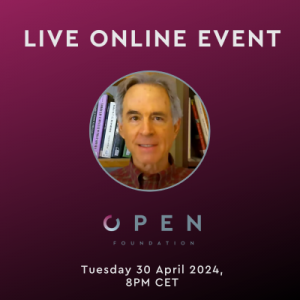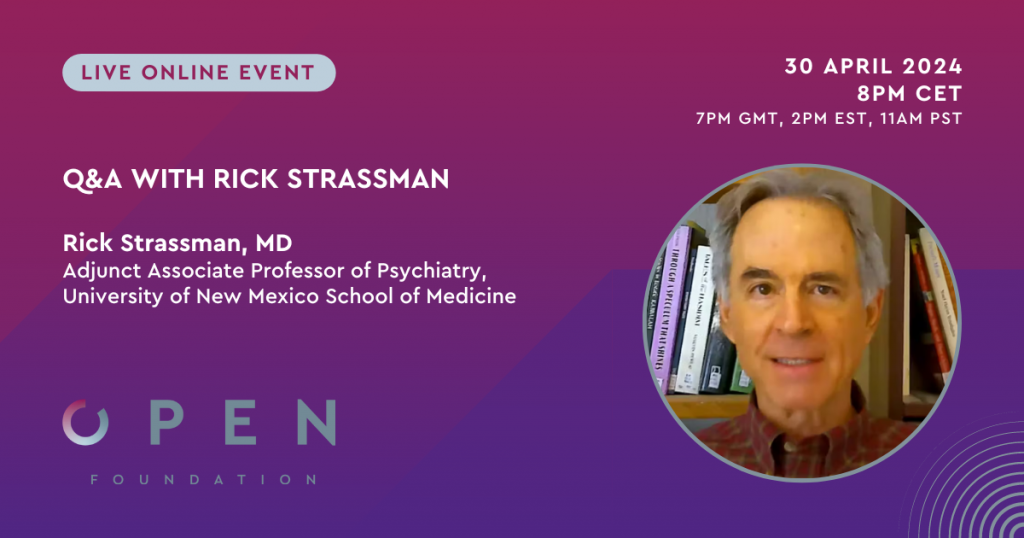Rick Strassman: At the forefront of DMT research
Touching on some chapters of the life and work of Dr. Strassman, from his academic pursuit with psychedelic substances to his profound insights into the innovative therapeutic models of DMT administration
Author: Simon Jost
Meet Rick Strassman

Join us for an exciting Q&A session with Dr. Rick Strassman, where we’ll delve into the fascinating realms of consciousness exploration, psychedelic research, and innovative DMT trials. Gain exclusive insights into Dr. Strassman’s groundbreaking work and have your burning questions answered live. Can’t make it? Don’t worry! The recording will be accessible to all members of our open community. Reserve your spot now by clicking here and embark on a journey of discovery with one of the foremost pioneers in psychedelic research.
Author of DMT – The spirit molecule & The Psychedelic Handbook
We are honoured to delve into the realms of consciousness exploration, clinical psychedelic research and innovative DMT trials together with the author and psychiatrist Dr Rick Strassman. Most people will associate his name with his bestselling publications, such as “DMT – The Spirit Molecule: A Doctor’s Revolutionary Research Into the Biology of Near-Death and Mystical Experiences”, and “The Psychedelic Handbook: A Practical Guide to Psilocybin, LSD, Ketamine, MDMA, and Ayahuasca”.
In this blog, we’ll touch on some chapters of the life and work of Dr. Strassman, from his academic pursuit with psychedelic substances to his profound insights into the innovative therapeutic models of DMT administration. Ultimately, the following article aims to introduce you to some of Dr Strassman’s earlier and current work with a special focus on N,N Dimethyltryptamine (DMT), the active component of ayahuasca. If you’re eager for further insights and have burning questions for Dr. Strassman, don’t miss the chance to participate in our upcoming online Q&A session.
—
Disclaimer:
This blog post is not dedicated to providing an exhaustive and elaborate description of Strassman’s biography, but rather aims to shed light on some of his important scientific endeavours, and spiritual journeys to prepare and facilitate an interesting OPEN Q&A session with Rick Strassman!
—
Dr. Strassmans Background and Earlier Career
Strassman’s journey begins in 1952 in the vibrant city of Los Angeles, California. His academic background started with his undergraduate studies in zoology at Pomona College in Claremont California, after which he transferred to Stanford University. Soon after in 1973, he graduated with departmental honors in biological sciences.
The next chapter of Dr Strassman’s journey unfolded at the Albert Einstein College of Medicine of Yeshiva University in the Bronx, New York, where he obtained his medical degree with honours in 1977. This pivotal moment set the stage for a career that would seamlessly blend academic rigour with spiritual exploration and scientific inquiry.
Continuing his career at the University of California, Davis Medical Center, he completed his general psychiatry residency, earning acclaim with the prestigious Sandoz Award for outstanding graduating resident in 1981. His subsequent work took him to the rugged landscapes of Fairbanks, Alaska, and the vibrant community of Albuquerque, New Mexico, where his research group were the first to document the role of melatonin in humans. Melatonin is secreted by the pineal gland in the human brain and plays an important role in sleep by setting and regulating the inner human clock (scientifically referred to as the circadian rhythm). Publically, his work is sometimes reduced to his important role as an author and his involvement in the first DMT research after the “War on Drugs”. However, it is important to understand Strassman’s early work because it played an important role in pursuing his future endeavours. Consequently, before zooming in on his work with psychedelics, I will briefly dedicate the next paragraph to acquaint you with some of his experience, study and practice in the world of religion and spirituality.
Religious and Spiritual Journey
Beyond academia, Dr. Strassman’s journey took him on a deeply personal and spiritual odyssey. He grew up in a Conservative Jewish home and underwent his bar mitzvah ritual. Following this, he ceased any formal affiliation or study within Judaism. His spiritual journey therefore begins with the practice of transcendental meditation during college. Located on the West Coast during the ’60s and early ’70s, Strassman was fortunate to be at the right place at the right time for taking a deep dive into the world of mindfulness meditation, Eastern religions and psychedelics.
Several years after his initial college experience with meditation, the psychiatrist commenced the deeper study and practice of Soto Zen Buddhism under the supervision and guidance of a Western Zen order. This practice was rewarded by receiving the Jukai (Lay Ordination). Eventually, he was administrating and guiding a lay Buddhist meditation group from the same order. His interest in consciousness exploration, spirituality and religion led him to the study of the Hebrew bible. In his bestselling book “DMT – The Spirit Molecule: A Doctor’s Revolutionary Research Into the Biology of Near-Death and Mystical Experiences” he dives deeper into the intimate connection between spirituality, consciousness, spirituality and DMT.

Photo by Marek Piwnicki, unsplash.com
Psychedelic Research inspired by Eastern religion
Inspired by his interest in Eastern religion, meditation practices and research expertise, he began his scientific endeavour with psychedelic substances and spirituality (more about his spiritual practices later). In an interview for “Medium”, he emphasised that it was the qualitative and descriptive overlap of psychedelic experiences and Eastern meditation practices that further nurtured his pursuit on attending a career in the field of psychedelic research.
As mentioned before, Strassmans earlier work focuses on the role of the pineal gland and melatonin in the human and mammalian brain. Interestingly, the pineal gland is often considered the “seat of the soul” in many religious and spiritual communities, with its significance dating far back to the times of the early Egyptians.
Eventually, based on evidence from Strassman and other researchers, it has been shown that the pineal gland can produce endogenous DMT, potentially accounting for profound experiences, such as birth and near-death experiences (Dean et al., 2019). Ultimately, the interplay of rigorous spiritual and religious exploration, combined with his earlier scientific work, Strassman’s curiosity paved a road that led him to become an important figure in early and current DMT research.
After the “war on drugs” and the associated pause of psychedelic research, Dr. Strassman was involved in conducting the first government-approved human experiments of psychedelic substances in the ’90s, with a special focus on the safety and psychopharmacology of DMT. While his earlier publications were often dedicated to the fundamental mechanism, safety and pharmacology of the drugs in a healthy population, his more recent research specified in exploring the therapeutic potential of DMT in stroke rehabilitation. Within this realm, Dr Strassman was and is involved in the investigation of prolonged intravenous infusions of DMT.
Prolonged DMT IV-Infusions
For the psychedelic-drug-educated reader, this sub-heading may come surprising, as serotonergic hallucinogenic drugs are usually accompanied by tolerance and cross-tolerance effects. However, as Rick Strassman describes in an interview with “Drug Discovery & Development”, in the early 90s his research team observed that one can repeatedly dose DMT without inducing tolerance. Being a researcher at heart, the psychiatrist sought and received funding from the NIH to investigate the tolerance effects of repeated DMT dosing in an experimental setting. In their research, they administered the psychedelic every 30 minutes four times and surprisingly did not note any tolerance effects. Consequently, the idea was planted that DMT may be induced as a prolonged intravenous infusion, rather than the more common method of smoking or intravenous bolus injections.
According to Strassman, this may be an interesting, innovative psychotherapy model for exploring the psychological, pharmacological and therapeutic effects of DMT in humans. While it is difficult to stop a full-blown psychedelic experience after a moderate to large bolus injection (one-time dosing) of magic mushrooms or LSD, one can vary the IV infusion rate of DMT to alter the strength of the experience. Once the IV infusion is stopped, the psychedelic experience will be over after a few minutes.
During his interview at Drug Discovery & Development, Dr Strassman shared insights into ongoing research at UCLA, where repeated dosing of DMT is being explored as a potential treatment for veterans with post-traumatic stress disorder (PTSD). This novel approach involves administering a substantial dose of DMT followed by periods of processing, allowing individuals to delve into their experiences over several hours. Continuous dosing, compared to one-time dosing offers clinicians the control to induce periods of rest and processing by reducing the infusion rate of the substance.
Additionally, results from the publication with Dr. Gallimore about the pharmacological effects of continuous dosing, this form of DMT administration may offer the opportunity to carefully characterize the subjective effects of the psychedelic compound. Furthermore, this protocol allows for a more controlled testing opportunity to use brain-imaging technologies to study the psychoneuropharmacological effects of the compound.
Conclusion
In closing, Dr. Rick Strassman’s pioneering work in consciousness exploration and psychedelic research offers a glimpse into the potential of these substances for therapeutic purposes. From his early studies on the pineal gland to his current investigations into prolonged DMT infusion, his journey underscores the profound connections between science, spirituality, and healing. As we continue to delve deeper into the mysteries of the mind, Dr. Strassman’s insights serve as a guiding light, illuminating new pathways for understanding and growth.
Are you curious about this topic or want to ask Rick Strassman a few questions? Join our upcoming online event!
By Simon Jost

